The Black-throated Loon, scientifically known as Gavia arctica, is a captivating bird species inhabiting northern regions of North America, Europe, and Asia.
Renowned for its striking appearance and haunting calls, this bird fascinates enthusiasts with its unique behaviors and adaptations.
With its sleek, streamlined body and expert diving abilities, the Black-throated Loon is an adept hunter, preying on fish and other aquatic creatures in freshwater lakes and coastal waters.
Despite its adaptability, the Black-throated Loon faces conservation challenges, including habitat loss and pollution.
Understanding the biology and ecology of this iconic bird species is crucial for its conservation and ensuring its continued presence in the wild. Stay sharp.
Physical Characteristics of Black-throated Loon
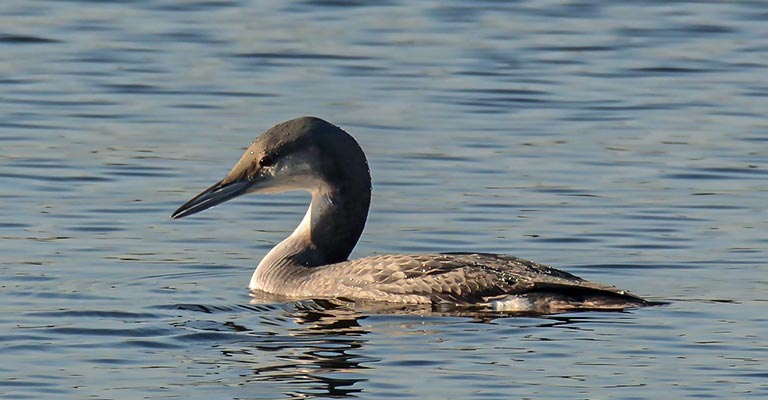
The Black-throated Loon, also known as the Arctic Loon or the Black-throated Diver, is a striking bird species found in the northern regions of North America, Europe, and Asia.
Its distinctive physical characteristics make it easily identifiable. Here are some of the key points to help you identify this specific bird:
Size and Shape
The Black-throated Loon is a medium-sized bird, measuring around 60 to 75 centimeters (24 to 30 inches) with a wingspan of approximately 110 to 130 centimeters (43 to 51 inches).
It has a sleek, streamlined body, long neck, and dagger-like bill.
Coloration
As the name suggests, the Black-throated Loon has a striking black throat during the breeding season, contrasting sharply with its white underparts.
Its head and neck are a deep blackish-brown, while the back and wings are a dark gray-brown. Outside of the breeding season, the throat becomes paler, often appearing grayish.
Distinctive Markings
One of the most noticeable features of the Black-throated Loon is its distinctive checkered or barred pattern on its back and wings. These markings are black, white, and gray, giving the bird a unique appearance.
Bill
The bill of the Black-throated Loon is long, straight, and sharply pointed, ideal for catching fish underwater. It is dark in color, often appearing blackish or dark gray.
Eyes
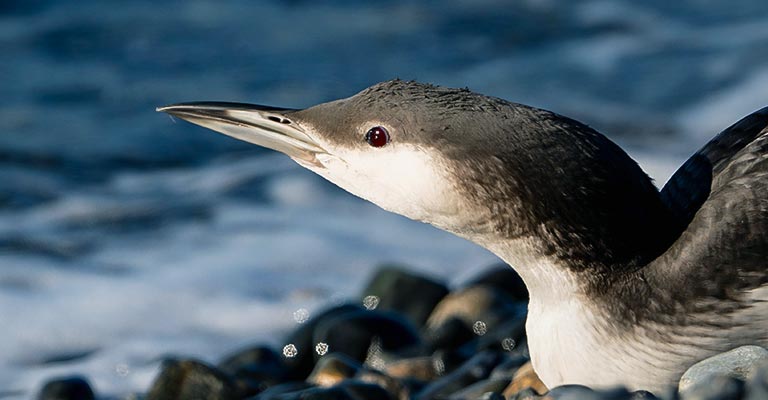
The eyes of the Black-throated Loon are ruby-red or dark red, adding to its striking appearance. The eye color contrasts vividly with the bird’s dark head and neck.
Breeding Plumage
During the breeding season, the Black-throated Loon exhibits more vital colors and patterns, particularly a prominent black throat. The overall plumage appears glossy and well-defined.
Flight Pattern
The Black-throated Loon displays a robust and direct flight with steady wing beats when in flight. Its wings are pointed and narrow, contributing to its swift aerial movement.
Habitat and Behavior
Black-throated Loons are typically found in freshwater lakes, ponds, and coastal marine waters during the breeding season.
They are skilled divers, capable of staying submerged for extended periods while hunting for fish. They may migrate to more sheltered coastal areas or open ocean waters outside the breeding season.
The Black-throated Loon is a visually striking bird with distinctive physical characteristics that make it easily identifiable.
Its black throat, checkered back and wings, long bill, and red eyes set it apart from other bird species, particularly during the breeding season.
Understanding these essential features can significantly aid in accurately identifying this beautiful avian species.
Taxonomy of Black-throated Loon
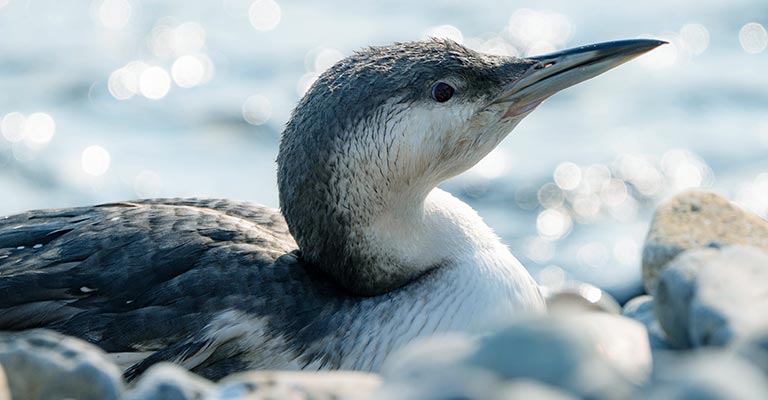
Find out the table below detailing the taxonomy details of the Black-throated Loon:
| Taxonomic Rank | Classification |
| Domain | Eukaryota |
| Kingdom | Animalia |
| Phylum | Chordata |
| Class | Aves |
| Order | Gaviiformes |
| Family | Gaviidae |
| Genus | Gavia |
| Species | G. arctica |
The two subspecies of the Black-throated Loon, Gavia arctica, exhibit distinct ranges and migration patterns, reflecting their adaptation to diverse habitats and environments. Here’s a closer look at each subspecies:
Gavia arctica arctica
This subspecies is primarily found in northern Europe, extending eastward to the center of north Asia, reaching as far as the Lena River and Transbaikal.
During the breeding season, individuals of this subspecies inhabit freshwater lakes and ponds in these northern regions.
They undertake migratory journeys to the coasts of northwestern Europe and the Mediterranean, Black, and Caspian Seas during the winter months.
The migration routes of G. a. arctica highlight the connection between its breeding grounds in the northern interior and its wintering areas along coastal regions.
Gavia arctica viridigularis
Found in eastern Russia, this subspecies ranges from the Lena River and Transbaikal eastward to the peninsulas of Chukotka and Kamchatka and the northern portion of Sakhalin.
G. a. viridigularis prefers similar breeding habitats to its counterpart, occupying freshwater lakes and ponds in the remote northern regions of Russia.
During migration, individuals of this subspecies migrate to the northwestern Pacific coasts, reflecting a more localized and coastal-oriented wintering range than G. a. arctica.
Despite these geographical distinctions, both subspecies of the Black-throated Loon share similar physical characteristics and behaviors, including their striking black throat patches and expert diving abilities.
However, their separate ranges and migration routes underscore the adaptability and resilience of this iconic bird species across diverse landscapes.
Common Food of Black-throated Loon
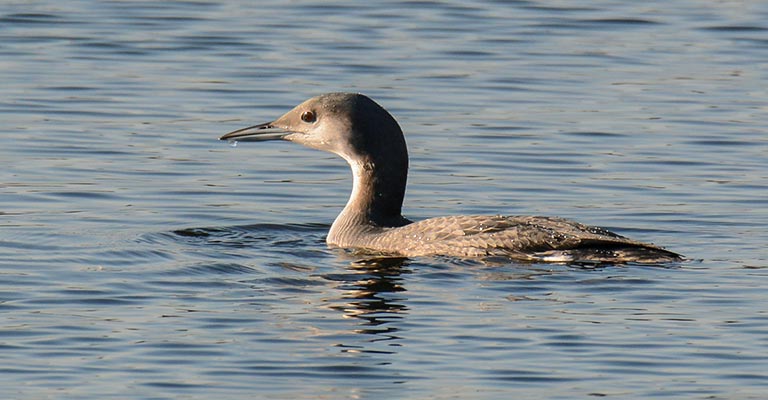
The Black-throated Loon primarily feeds on a diet of aquatic prey, which it obtains through skilled diving and underwater foraging. Some of the common foods in its diet include:
- Fish: Black-throated Loons predominantly consume small to medium-sized fish species such as perch, trout, and sticklebacks. They hunt these fish by diving underwater and using their sharp bills to catch them.
- Crustaceans: Crayfish and various crustaceans are also a significant part of the Black-throated Loon’s diet. These aquatic invertebrates provide an additional source of protein and nutrients.
- Amphibians: Black-throated Loons may also prey on amphibians such as frogs and tadpoles when available during certain seasons.
- Insects: Insects and their larvae, including aquatic insects like dragonfly nymphs and water beetles, are occasionally consumed, particularly by young Black-throated Loons.
The Black-throated Loon’s diet is primarily composed of fish and supplemented with crustaceans, amphibians, and insects, depending on availability and seasonal variations in prey abundance.
Black-throated Loon Life History
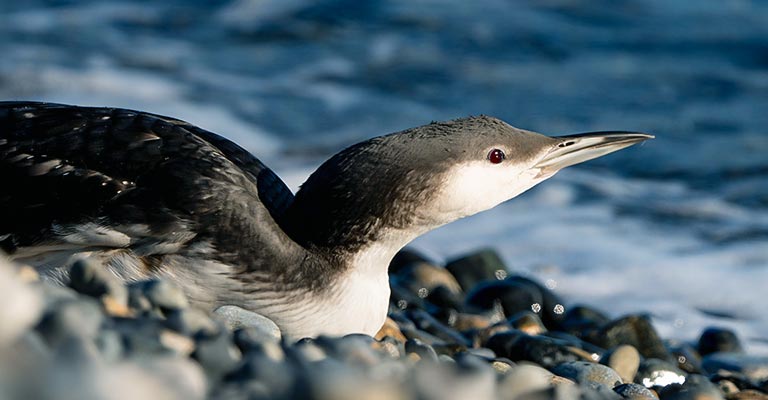
The Black-throated Loon, scientific name Gavia arctica, is a captivating bird species inhabiting the northern regions of North America, Europe, and Asia.
Specialized habitat requirements, unique nesting behaviors, and conservation concerns characterize its life history.
Habitat
Black-throated Loons are primarily found in freshwater lakes, ponds, and rivers during breeding.
They prefer clear, unpolluted waters with abundant fish populations for hunting. They may migrate to coastal marine waters, bays, and estuaries outside the breeding season.
Range Map
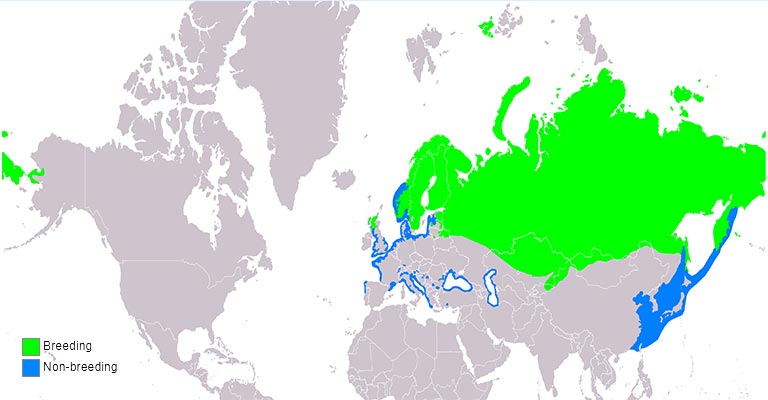
The range of the Black-throated Loon extends across the northern latitudes of North America, Europe, and Asia.
It breeds in northern Canada, Alaska, Scandinavia, and Siberia, while its wintering grounds include coastal areas of the North Atlantic, North Pacific, and northern Eurasia.
Nesting
Black-throated Loons build their nests near the water’s edge, typically on small islands or remote shores, to minimize disturbance.
The nest is a shallow depression lined with vegetation and feathers. Both males and females participate in nest-building and incubating the eggs.
Check out the table below detailing the nesting details of the Black-throated Loon:
| Nesting Details | Facts |
| Clutch Size | 1-3 eggs |
| Number of Broods | Typically 1 brood per breeding season |
| Egg Length | Approximately 7.5 – 9 centimeters (3 – 3.5 in) |
| Egg Width | Approximately 4.5 – 5.5 centimeters (1.8 – 2.2 in) |
| Incubation Period | Around 25-30 days |
| Nestling Period | 6-10 weeks |
| Egg Description | Oval-shaped; smooth and slightly glossy shell; coloration varies, typically light brown or olive with darker spots or blotches |
This table provides a concise overview of the nesting characteristics of the Black-throated Loon, including clutch size, egg dimensions, incubation and nestling periods, and egg description.
Breeding
Breeding occurs in late spring and early summer when the birds return to their breeding grounds. Males perform elaborate courtship displays involving calls and ritualized behaviors to attract mates.
Females typically lay 1-3 eggs, which are incubated for around 25-30 days. Both parents take turns incubating the eggs and caring for the young.
Diseases and Treatment
Black-throated Loons may be susceptible to various diseases and parasites, including avian botulism, avian influenza, and parasites like ticks and lice.
Monitoring for disease outbreaks and implementing measures such as habitat restoration and reducing pollution can help mitigate these threats.
In cases of illness, affected individuals may require veterinary intervention and supportive care.
Conservation
The Black-throated Loon faces several conservation challenges, including habitat loss, pollution, and disturbance from human activities such as boating and fishing.
Conservation efforts focus on protecting critical breeding and wintering habitats, minimizing disturbance, and addressing threats like oil spills and climate change.
Collaborative conservation initiatives involving governments, NGOs, and local communities are crucial for ensuring the long-term survival of this iconic bird species.
10 Fun Facts About Black-throated Loon
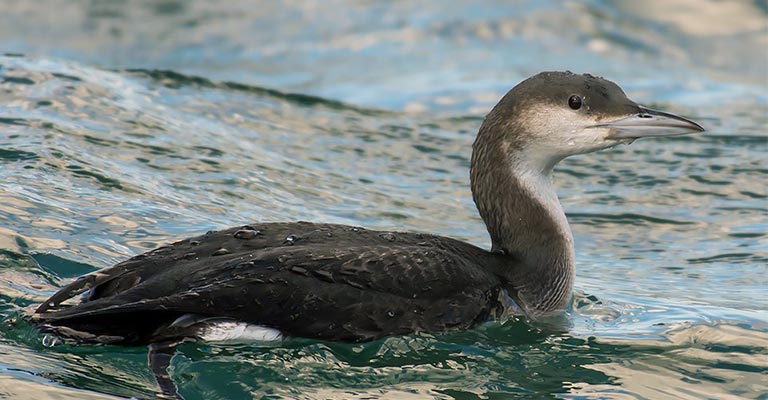
With its striking appearance and fascinating behaviors, the Black-throated Loon captivates bird enthusiasts worldwide. Here are ten fun facts that shed light on the intriguing nature of this remarkable bird species:
- Distinctive Call: The Black-throated Loon is known for its haunting wails and yodel-like calls, which echo across its breeding grounds during the mating season.
- Expert Diver: With its streamlined body and powerful legs, the Black-throated Loon can dive to impressive depths of up to 60 meters (200 feet) in search of prey.
- Underwater Hunting: Equipped with sharp bills and keen eyesight, these birds are adept underwater hunters, preying on fish, crustaceans, and small amphibians.
- Monogamous Pairing: Black-throated Loons form monogamous pairs during the breeding season, often returning to the same nesting sites year after year.
- Elaborate Courtship Displays: Males use elaborate courtship displays, including synchronized swimming and vocal performances, to attract mates.
- Protective Parents: Both parents take turns incubating the eggs and caring for the young, showing remarkable dedication to their offspring.
- Long-Distance Migrations: Black-throated Loons travel thousands of kilometers to reach their wintering grounds in winter.
- High-Speed Flight: These birds exhibit swift and direct movements, with their pointed wings slicing through the air at impressive speeds.
- Beautiful Plumage: The breeding plumage of the Black-throated Loon is characterized by glossy black throats and intricate checkered patterns on their backs and wings, adding to their aesthetic appeal.
- Conservation Concerns: Despite their adaptability, Black-throated Loons face conservation challenges such as habitat loss, pollution, and disturbance, underscoring the importance of conservation efforts to safeguard their populations.
These fascinating facts offer a glimpse into the captivating world of the Black-throated Loon, highlighting its unique adaptations, behaviors, and conservation needs.
Wrapping Up
The Black-throated Loon is a remarkable bird species with its striking appearance, intriguing behaviors, and conservation challenges.
From haunting calls to expert diving abilities, this bird inspires awe and fascination among bird enthusiasts worldwide.
By understanding and appreciating the unique qualities of the Black-throated Loon, we can work towards conserving its habitats and ensuring its survival for generations to come. Thank you so much.